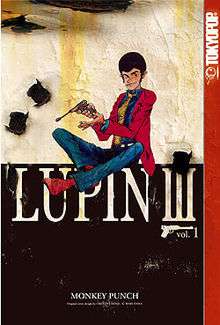Lupin III (manga)
Lupin III (Japanese: ルパン三世, Hepburn: Rupan Sansei) is a Japanese manga series written and illustrated by Monkey Punch. It follows the escapades of master thief Arsène Lupin III, the grandson of Arsène Lupin, the gentleman thief of Maurice Leblanc's series of novels.
| Lupin III | |
 First English-language volume of Lupin III released by Tokyopop. | |
| ルパン三世 (Rupan Sansei) | |
|---|---|
| Genre | Action, comedy[1] |
| Manga | |
| Written by | Monkey Punch |
| Published by | Futabasha Chuokoron-Shinsha |
| English publisher | |
| Magazine | Weekly Manga Action |
| Demographic | Seinen |
| Original run | August 10, 1967 – May 22, 1969 |
| Volumes | 14 |
Lupin III began serialization in Weekly Manga Action on August 10, 1967 and has spawned a media franchise that includes several manga, five animated television series, six theatrically-released animated films, two live-action films, twenty-six animated television specials, two musicals, and numerous music CDs and video games. The manga was released in North America by Tokyopop between 2002 and 2004.
Premise
Arsène Lupin III, the grandson of the fictional gentleman thief, Arsène Lupin, is considered the world's greatest thief, known for announcing his intentions to steal valuable objects by sending a calling card to the owners of his desired items. His right-hand man and closest ally is Daisuke Jigen, an expert marksman who can accurately shoot a target in 0.3 seconds. Although Lupin and Jigen frequently work as a two-man team, they are often joined by Goemon Ishikawa XIII, a master swordsman whose sword can cut anything, or Fujiko Mine, a femme fatale and Lupin's love interest. Although Fujiko usually works together with the others, she occasionally exploits Lupin's interest in her to steal the treasure for herself. Lupin and his gang are constantly chased by Inspector Koichi Zenigata of the ICPO, who has made it his life's work to arrest them, pursuing Lupin across the globe.
Production

The series was created by Japanese manga artist Kazuhiko Katō under the pen name Monkey Punch. When Futabasha decided to start a weekly magazine, they asked him to create a series for it, which became Lupin III.[2] His inspiration for the series was the fictional French gentleman thief Arsène Lupin, created by Maurice Leblanc. Before creating the series he read 15 of Leblanc's stories. The aim of the Lupin III series was to produce a comedy adventure series that reflected the traits of Leblanc's character. Originally the intention was to keep the blood ties between the two fictional characters secret, however he was convinced by others not to do so.[3]
When Monkey Punch began Lupin III, he was already working on another series, Pinky Punky. Monkey Punch enjoys writing outlaw characters, and both Lupin III and Pinky Punky made use of outlaws as central characters. According to him, this made it easy for him to write two series without much pressure. Monkey Punch enjoys puzzles and mysteries such as Columbo and Agatha Christie novels, and was also inspired by The Three Musketeers and the movies of Alfred Hitchcock.[4][5] He believes the characters of Lupin and Fujiko are similar to the characters of D'Artagnan and Milady de Winter, and describes them as "Not necessarily lovers, not necessarily husband and wife, but more just having fun as man and woman with each other".[5] Another influence on the manga was Mad magazine.[6] Monkey Punch said the appeal of drawing Lupin comes from the character being able to go anywhere without obstacles and being able to do whatever he wants, whenever he wants. However, this is contrasted by the appeal of Zenigata's strict personality. Originally the series was only expected to last three months, but due to its popularity, Monkey Punch continued to draw it. However, despite his happiness at its success, he has expressed confusion over its popularity.[5]
Monkey Punch has said that he believes the story can never end but that if he had to, both Zenigata and Lupin would have to end as equals. They would either both fail, both win or both get very old.[7]
Characters
Monkey Punch combined elements of Arsène Lupin with James Bond to develop the character of Lupin III and made him a "carefree fellow". Lupin was given a red color jacket which Monkey Punch believes is a flashy, sexy color.[3][4][8] As the series was to be published in a magazine targeted at adults, Fujiko Mine was created to add a female presence and to fulfill a "Bond girl" role. Her name was inspired by a picture of Mount Fuji, Monkey Punch added the -ko female suffix to create her first name, and chose "Mine" for her family name because of its meaning as "summit". At the beginning of the series, many of the women Lupin encounters are all named Fujiko, but are treated as different characters from chapter to chapter. Creating a new female each week was too difficult for Monkey Punch so she evolved into a single character who changes style frequently.[3][8][9] Jigen was based on James Coburn, especially his role in The Magnificent Seven, and his name was chosen to reflect his unconventional personality. Goemon was created to give an oriental element into an otherwise western series. Despite Lupin and Goemon originally being enemies, Monkey Punch decided that they were on the same wavelength. While Lupin, Fujiko, Jigen and Goemon frequently operate together for their own goals, the author considers them not to be a true group as they have their own individual interests.[3] Inspector Zenigata was conceived as Lupin's archrival to create a "human Tom and Jerry".[8]
Copyright issues
Monkey Punch did not ask permission to use the Arsène Lupin name and at the time Japan did not enforce trade copyrights. By the time Leblanc's estate launched legal action in Japan, the name was considered to have entered into common use.[3] Monkey Punch has stated that using the same character design, behavior and face would be illegal, but using a name alone is not illegal.[4]
Publication
The original manga series was written and illustrated by Monkey Punch. It was serialized by Futabasha in Weekly Manga Action in 94 chapters from August 10, 1967. Additional chapters known as Lupin III New Adventures (ルパン三世 新冒険, Rupan Sansei Shin Bōken) were released from August 12, 1971.[10][11] Monkey Punch stated that there was a bitter dispute between Futabasha and Chuokoron Shinsha over who would publish the collected volumes of the series. The artist revealed that a compromise was made where each company would publish half.[2] Tokyopop licensed the series for North America, and released all 14 volumes between December 10, 2002 and July 6, 2004.[12][13] The Tokyopop edition is adapted from the Chuokoron Shinsha edition from 1989.[14] In Europe, the series was licensed by Star Comics in Italy and Ediciones Mangaline in Spain.[15][16]
Reception
In Manga: The Complete Guide, Jason Thompson referred to Monkey Punch's original manga as "a crazy, groovy 1960s world of dynamite and backstabbing, hippies and gangsters", and considered it "a fascinating homage to Mad magazine and a four star example of comics as pure comedy." He rated the series four out of four stars.[17] Allen Divers of Anime News Network (ANN) praised the strong writing and action; however, he felt that the art was too primitive.[18] Otaku USAs Daryl Surat was also put off by the art, saying he couldn't tell most character apart and had a hard time figuring out what he was looking at. In The Rough Guide to Manga, Jason S. Yadao highlighted the example of how Lupin wearing a hat looks exactly like Zenigata. However, he considered it a successful plot device in once chapter that while it may take several attempts to understand, eventually pays off. He included the series in his list of 50 essential manga.[7] Many of the first volumes of the English edition of the Lupin III manga released by Tokyopop made it onto ICv2's list of top 50 graphic novels, as well as later volumes from the series.[19][20][21]
References
- "Lupin III Volume 1". Tokyopop. Archived from the original on January 6, 2006. Retrieved May 29, 2018.
- "A Few Stolen Moments with Monkey Punch". Mangazine. Antarctic Press. January 1995.
- "Manga Mania" (20). Manga Publishing. March 1995: 6–9. ISSN 0968-9575. Cite journal requires
|journal=(help) - "Manga Mania" (34). Manga Publishing. May 1996. Poster Magazine Insert. ISSN 0968-9575. Cite journal requires
|journal=(help) - Divers, Allen (November 13, 2003). "Interview: Monkey Punch". Anime News Network. Archived from the original on July 15, 2007. Retrieved July 2, 2007.
- Monkey Punch Interview (DVD Extra). Lupin the 3rd: Dead or Alive (DVD). Funimation Entertainment.
- Yadao, Jason S. (2009). The Rough Guide to Manga. Rough Guides. pp. 154–155. ISBN 978-1-85828-561-0.
- Interview with Monkey Punch. Lupin the 3rd: Dead or Alive (DVD). Funimation.
- Surat, Daryl (February 2013). "Otaku USA". 6 (4). Sovereign Media: 86. ISSN 1939-3318. Cite journal requires
|journal=(help) - "ルパン三世DVDコレクション" (01). Kodansha: 16–17. Cite journal requires
|journal=(help) - McCarthy, Helen (March 1995). "Anime UK". 1 (1): 44–45. Cite journal requires
|journal=(help) - "Lupin III Volume 1". Tokyopop. Archived from the original on January 6, 2006. Retrieved November 26, 2014.
- "Lupin III Volume 14". Tokyopop. Archived from the original on January 6, 2006. Retrieved November 26, 2014.
- McCarthy, Helen. 500 Manga Heroes & Villains. Collins & Brown. pp. 178–179. ISBN 1-84340-234-3.
- "Collana : LUPIN III PRIMA SERIE M13". Star Comics. Archived from the original on March 4, 2014. Retrieved February 23, 2014.
- "Ediciones Mangaline" [To access, click on Series, Colleciòne 38 mm & pagina: 2] (in Spanish). Ediciones Mangaline. Retrieved July 10, 2009.
- Thompson, Jason (October 9, 2007). Manga: The Complete Guide. New York, New York: Del Rey. p. 196. ISBN 978-0-345-48590-8. OCLC 85833345.
- Divers, Allen (July 2, 2003). "A New Beginning — Tankobon Tower". Anime News Network. Archived from the original on February 24, 2014. Retrieved March 11, 2014.
- "Top 50 Graphic Novels—January 2003". ICv2. Archived from the original on February 3, 2014. Retrieved March 11, 2014.
- "Top 50 Graphic Novels—March 2003". ICv2. Archived from the original on October 23, 2012. Retrieved March 11, 2014.
- "Top 50 Graphic Novels Actual—June 2003". ICv2. Archived from the original on February 3, 2014. Retrieved March 11, 2014.